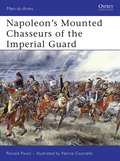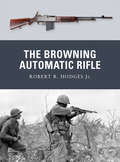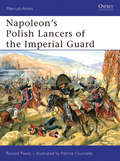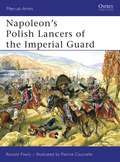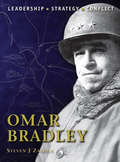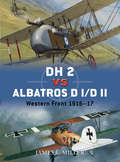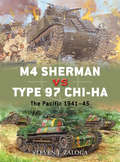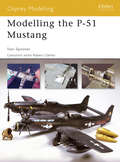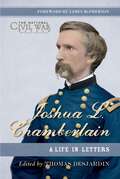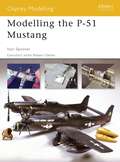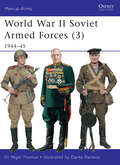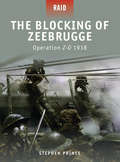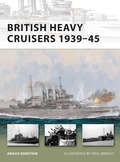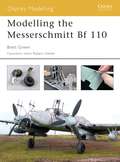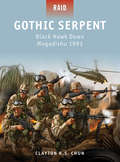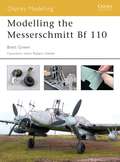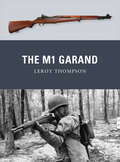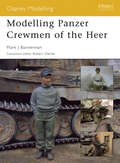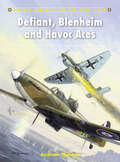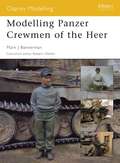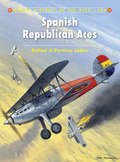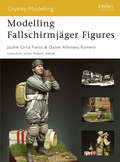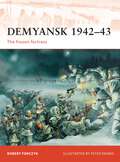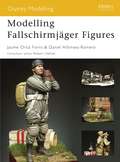- Table View
- List View
Napoleon’s Mounted Chasseurs of the Imperial Guard (Men-at-Arms)
by Patrice Courcelle Ronald PawlyA concise history of the hand-picked elite cavalry guard that served as Napoleon's close personal escort and were committed to the most dangerous areas of combat on the battlefield. Formed from his original escort of 'Guides' and the 'Consular Guard' in 1799, the Mounted Chasseurs were a personal favourite of the Emperor, who wore their uniform on campaign. Ronald Pawly's unique research into regimental archives has uncovered unprecedented detail about this exceptional unit and its soldiers and officers. With their colourful uniforms recreated in full-colour artwork and accounts of their actions in the most critical Napoleonic battles, this book provides a comprehensive description of these legendary elite soldiers.
The Browning Automatic Rifle (Weapon #15)
by Johnny Shumate Alan Gilliland Robert R. Hodges Jr. Robert R. HodgesFor nearly fifty years the hard-hitting, mobile Browning Automatic Rifle, or BAR, served in US infantry units as a light squad automatic "base of fire†? weapon, providing quick bursts of concentrated fire. Designed in World War One, it didn't reach the front until September 1918. In the interwar years US forces used the BAR across the world, from China to Nicaragua. It also became a favorite of notorious gangsters like Clyde Barrow and Bonnie Parker, who prized its ability to punch through police armored cars. At the outset of World War II the US armed forces decided to adapt the BAR for a light machine gun role. The BAR was not without its flaws; it was heavy and difficult to dismantle and reassemble, and it didn't cope well with sustained fire. Nevertheless, the BAR saw action in every major theater of World War II and went on to be used in Korea and in the opening stages of the Vietnam War. Featuring arresting first-hand accounts, specially drawn full-color artwork and close-up photographs, many in color, this lively study offers a vivid portrait of this powerful, long-lived and innovative weapon that saw service with US and other forces across the world for much of the 20th century.
Napoleon’s Polish Lancers of the Imperial Guard (Men-at-Arms #440)
by Patrice Courcelle Ronald PawlyThis book draws on original regimental records to give by far the most detailed account ever published in English of the organization and personalities of the most renowned of the foreign units that served in the Emperor's armies. Unlike most of his foreign troops, these Polish horsemen were true volunteers, who owed their honoured place in his Imperial Guard to their proven courage and dash on battlefields from Spain to Russia. The text is illustrated with rare portraits and photographs, and with detailed colour plates of the Lancers' magnificent uniforms.
Napoleon’s Polish Lancers of the Imperial Guard (Men-at-Arms)
by Patrice Courcelle Ronald PawlyThis book draws on original regimental records to give by far the most detailed account ever published in English of the organization and personalities of the most renowned of the foreign units that served in the Emperor's armies. Unlike most of his foreign troops, these Polish horsemen were true volunteers, who owed their honoured place in his Imperial Guard to their proven courage and dash on battlefields from Spain to Russia. The text is illustrated with rare portraits and photographs, and with detailed colour plates of the Lancers' magnificent uniforms.
Omar Bradley (Command #25)
by Steven J. Zaloga Mr Steve NoonGeneral Omar Bradley was the premier US Army tactical commander in the European Theatre of Operations in 1944–45. A West Point classmate of Dwight Eisenhower, Bradley was the quintessential US field commander of World War II, elevated to high command with little combat experience but a solid track record as a skilled planner and organiser. Bradley was part of a small cadre of highly skilled young officers groomed for higher command in the austere and bankrupt 1930s. Bradley was at the centre of nearly all the major US Army victories in 1944–45 from D-Day through the final push into Germany. Along with that combat record came a string of controversies. Bradley's greatest blunder, failing to anticipate the German offensive in the Ardennes, was counter-balanced by a vigorous and skilled response which fatally injured the German Army in the West. Beyond the performance of the US Army in the ETO, Bradley was also intimately wrapped up in other controversies, especially the internecine squabbles with his British counterpart, Bernard Montgomery.
DH 2 vs Albatros D I/D II: Western Front 1916 (Duel #42)
by Jim Laurier Mr Mark Postlethwaite James F. MillerFlown by Victoria Cross recipient Lanoe Hawker and the members of No 24 Sqn, the ungainly yet nimble DH 2 helped the Allies attain air superiority over the Somme in early 1916 and hold it through the summer. With its rotary engine 'pusher' configuration affording excellent visibility and eliminating the need for a synchronized machine gun, the DH 2 was more than a match for anything the Germans could put in the air. That is, until the arrival of the Albatros D II, a sleek inline-engined machine built for speed and with twin-gun firepower. Thus, the later part of 1916 saw an epic struggle in the skies above the Somme pitting the manoeuvrable yet under-gunned DH 2s against the less nimble yet better armed and faster Albatros D IIs. In the end the Germans would regain air superiority, three squadron commanders – two of whom were considered pinnacles of their respective air forces – would lose their lives, and an up-and-coming pilot (Manfred von Richthofen) would triumph in a legendary dogfight and attain unimagined heights fighting with tactics learned from a fallen mentor.
M4 Sherman vs Type 97 Chi-Ha: The Pacific 1945 (Duel #43)
by Steven J. Zaloga Richard ChasemoreAlthough US and Japanese tank forces first clashed in 1941, it was on in 1944 that tank-vs-tank action became more common as both sides poured larger numbers of tanks into the combat zone. These battles were a means of demonstrating each side's latest tank technology. For the US, the pinnacle of their tank machinery came in the form of the M4 Sherman and for the Japanese, their most notable feat of engineering was the smaller, yet still effective Type 97 Chi-Ha. The last two campaigns of the war – Iwo Jima and Okinawa – saw tanks used by both sides, the Japanese finally concluding that "the fight against the US Army is a fight against his M4 tanks†?. The illustrations follow the usual Duel pattern with profile illustrations of the Type 97-kai Shinhoto Chi-ha and the M4A3, views showing the ammunition of both types, interior illustrations showing the turret layout in both types, and a battlescene showing the Type 97-kai in combat against US armour.
Modelling the P-51 Mustang (Osprey Modelling #34)
by Stan SpoonerThe North American P-51 Mustang had a humble genesis as a British request for single engine escort fighters but became, arguably, World War II's most important fighter aircraft. It had incredible endurance, fantastic maneuverability and excellent high-altitude performance, and served throughout World War II and beyond. This aircraft is one that holds a great deal of interest for many modellers around the world. This book takes the modeller from the aircraft's beginnings to the ultimate manifestation of this elegant and deadly bird, the F-82 G/H Twin Mustang. Special attention is paid to painting both both interiors and exteriors, with a wide range of different schemes used.
Joshua L. Chamberlain: The Life in Letters of a Great Leader of the American Civil War
by Thomas Desjardin The National MuseumHis life is a remarkable story of perseverance, tragedy and triumph. From an insecure young man with a considerable stutter who grew up in a small town in eastern Maine, Joshua Chamberlain rose to become a major general, recipient of the Medal of Honor, Governor of Maine and President of Bowdoin College. His writings are among the most oft-quoted of all Civil War memoirs, and he has become a legendary, even mythical historical figure. In 1995, the National Civil War Museum acquired a collection of approximately three hundred letters written by or sent to Chamberlain from his college years in 1852 to his death in 1914. Author Thomas Desjardin puts Chamberlain's words in contemporary and historical context and uses this extraordinary collection of letters to reveal – for the first time – the full and remarkable life of Joshua Chamberlain
Joshua L. Chamberlain: The Life in Letters of a Great Leader of the American Civil War
by Thomas Desjardin The National MuseumHis life is a remarkable story of perseverance, tragedy and triumph. From an insecure young man with a considerable stutter who grew up in a small town in eastern Maine, Joshua Chamberlain rose to become a major general, recipient of the Medal of Honor, Governor of Maine and President of Bowdoin College. His writings are among the most oft-quoted of all Civil War memoirs, and he has become a legendary, even mythical historical figure. In 1995, the National Civil War Museum acquired a collection of approximately three hundred letters written by or sent to Chamberlain from his college years in 1852 to his death in 1914. Author Thomas Desjardin puts Chamberlain's words in contemporary and historical context and uses this extraordinary collection of letters to reveal – for the first time – the full and remarkable life of Joshua Chamberlain
Modelling the P-51 Mustang (Osprey Modelling)
by Stan SpoonerThe North American P-51 Mustang had a humble genesis as a British request for single engine escort fighters but became, arguably, World War II's most important fighter aircraft. It had incredible endurance, fantastic maneuverability and excellent high-altitude performance, and served throughout World War II and beyond. This aircraft is one that holds a great deal of interest for many modellers around the world. This book takes the modeller from the aircraft's beginnings to the ultimate manifestation of this elegant and deadly bird, the F-82 G/H Twin Mustang. Special attention is paid to painting both both interiors and exteriors, with a wide range of different schemes used.
World War II Soviet Armed Forces: 1944–45 (Men-at-Arms #469)
by Nigel ThomasThis book presents a detailed analysis of the Soviet armed forces during the final days of the war, covering the soldiers that successfully turned the tide against the Nazi onslaught and pushed it back into Germany itself. This final part of the series documents the Red Army's push through Germany to Berlin, which eventually culminated in the surrender of the German forces to the Allies in 1945. It also offers a detailed breakdown of all the armed forces that conducted the offensive campaigns on the Eastern Front, including the army, air force, paratroopers, navy and NKVD troops. Its colourful illustrations also include the uniforms and organizations of the Russian forces serving against Japan until the eventual surrender of all Japanese Imperial forces in August 1945.
The Blocking of Zeebrugge: Operation Z-O 1918 (Raid #7)
by Giuseppe Rava Donato Spedaliere Stephen PrinceOn the night of 22–23 April 1918 the Royal Navy carried out a raid on the German held ports of Zeebrugge and Ostend – Operation Z-O. Under the cover of clouds and smoke, over 70 ships and an assault force of 1,800 Royal Marines embarked on a daring mission which involved a vicious battle of incredible intensity. However, despite the gallant and courageous efforts of the attackers, 11 of whom were later awarded the Victoria Cross, the raid was only partly successful. Discover the successes and failures of this dramatic raid in this in-depth account, complete with specially commissioned battlescene artwork. The author reveals how despite failure, the raid demonstrated to Germany that Britain was still capable of offensive action, even as its armies were being forced back.
British Heavy Cruisers 1939–45 (New Vanguard #190)
by Angus Konstam Mr Paul WrightThe idea of a heavy cruiser emerged in the aftermath of World War I, and was closely linked to the limits set by the inter-war Washington Naval Treaty. The pre-World War I concept of armoured cruisers had been abandoned, but in their stead the Admiralty saw a place for powerful cruisers, able to patrol the sea lanes of the British Empire, and which were well-armed enough that they could destroy enemy commerce cruisers. The result was a group of British warships, known as the 'Washington Treaty Cruisers', that did everything the Admiralty wanted, but which conformed to the limits imposed by the treaty. These impressive cruisers were high-sided, spacious and stately – perfect peacetime ambassadors for British power. In war they also packed a considerable punch. During World War II the Royal Navy's thirteen heavy cruisers saw service in every theatre of the war, whether facing the Bismarck in the North Atlantic or enduring kamikaze attacks in the Pacific.
Modelling the Messerschmitt Bf 110 (Osprey Modelling #2)
by Brett GreenThe Messerschmitt Bf 110 was undoubtedly one of the most significant aircraft of World War II. Despite suffering setbacks in the summer of 1940 at the hands of the RAF, it continued to be used effectively in other theatres and roles until the last days of the war, particularly as a night fighter against RAF Bomber Command's strategic bombing campaign over the Reich. This title shows you how to correct and convert basic 1/48-scale kits of the Bf 110 into many different variants, using a wide selection of aftermarket detail sets, conversions, accessories and decals for both day and night fighter schemes.
Gothic Serpent: Black Hawk Down Mogadishu 1993 (Raid #31)
by Johnny Shumate Clayton Chun Alan GillilandThis book tells the story of Task Force Ranger – a unit of US Rangers and Special Forces – and their attempt to capture the lieutenants of the Somali warlord Muhamed Farrah Aideed, during the 1993 United Nations' humanitarian relief mission. What started as a simple snatch-and-grab mission quickly degenerated into a desperate battle for survival when US Black Hawk helicopters were struck by rocket-propelled grenades and crashed into the streets of Mogadishu. Racing to save the crew, Task Force Ranger was surrounded by mobs of hostile Somali gunmen. The battle in the city raged all night as the better-equipped and better-trained US forces kept the nearly overwhelming numbers of Somalis at bay. Finally, battered, bloodied, and low on ammunition, the Task Force was rescued by a combined UN and US relief force and extracted to safety. Containing detailed maps and declassified information, this is a dramatic retelling of a brutal battle that had a far-reaching impact on US military policy.
Modelling the Messerschmitt Bf 110 (Osprey Modelling)
by Brett GreenThe Messerschmitt Bf 110 was undoubtedly one of the most significant aircraft of World War II. Despite suffering setbacks in the summer of 1940 at the hands of the RAF, it continued to be used effectively in other theatres and roles until the last days of the war, particularly as a night fighter against RAF Bomber Command's strategic bombing campaign over the Reich. This title shows you how to correct and convert basic 1/48-scale kits of the Bf 110 into many different variants, using a wide selection of aftermarket detail sets, conversions, accessories and decals for both day and night fighter schemes.
The M1 Garand (Weapon #16)
by Leroy ThompsonThe M1 Garand gave the US infantryman a marked edge during World War II. It shot faster and further than enemy infantry rifles and hit harder. No less an authority on killing the enemy than General George S. Patton called the Garand, “The greatest battle implement ever devised.” At a time when opposing forces were armed with bolt-action rifles, US troops had a highly reliable self-loader. The eight-round clips which were used to load the M1 Garand were, however, viewed with mixed emotions by the troops on the ground. Some Army and Marine Corps troops allegedly felt that the distinctive “twang” as the Garand's clip was ejected when empty alerted the enemy that the soldiers were reloading and resulted in an attack. But the Garand became the defining mankiller of the war, despite its weight and magazine problems, and many US combat veterans consider it one of the key reasons they survived the war.
Modelling Panzer Crewmen of the Heer (Osprey Modelling)
by Mark BannermanA wonderfully detailed and beautifully finished armour model can easily be let down if accompanied by a poorly painted figure. The addition of scale figures helps provide depth, weight and realism to a model yet working with figures continues to be most armour modellers' worst nightmare. This book provides tips and techniques for building, converting and painting World War II German Army Panzer crew figures, in clear step-by-step instructions. Among the topics covered are how to paint different uniforms using enamels and oils; converting and scratch-building figures; painting heads and flesh tones; and weathering clothing.
Defiant, Blenheim and Havoc Aces (Aircraft of the Aces #105)
by Andrew ThomasThe Blenheim IF flew some of Fighter Command's early offensive operations, and the type soon proved vulnerable when pitted against single-seat fighters. However, for much of 1940 the Blenheim fighter squadrons provided the RAF's main long-range convoy escort and nightfighter capability. In the mid-1930s, in an attempt to capitalise on its expertise in power-operated gun turrets, the Boulton Paul Company developed the Defiant, a single-engined fighter in which all the armament was concentrated in the turret behind the pilot. Intended as a 'bomber destroyer', the Defiant had its combat debut over Dunkirk, and initially achieved some considerable success. A number of American-built aircraft called Douglas DB-7 light bombers (named Havoc by the RAF), were fitted with radar for nightfighter duties and others successfully replaced the Blenheim as night intruders. A total of 11 pilots claimed five or more victories when flying these three types to become aces, whilst no fewer than 33 who became aces claimed at least part of their scores when flying the Blenheim, Defiant or Havoc.
Modelling Panzer Crewmen of the Heer (Osprey Modelling)
by Mark BannermanA wonderfully detailed and beautifully finished armour model can easily be let down if accompanied by a poorly painted figure. The addition of scale figures helps provide depth, weight and realism to a model yet working with figures continues to be most armour modellers' worst nightmare. This book provides tips and techniques for building, converting and painting World War II German Army Panzer crew figures, in clear step-by-step instructions. Among the topics covered are how to paint different uniforms using enamels and oils; converting and scratch-building figures; painting heads and flesh tones; and weathering clothing.
Spanish Republican Aces (Aircraft of the Aces #106)
by Rafael A López Permuy Julio López CaeiroAt the start of the Spanish Civil War, most young fighter pilot officers joined the rebels, while the high ranking officers, grupo or escuadrilla commanders, and the NCOs, sergeants and corporals remained loyal to the government. Mostly flying the obsolete Nieuport Ni.52s these loyalists were soon outpaced by the more modern Fiat CR.32s and Heinkel He 51s. However, at this early stage of the war, there were several Republican airmen who became aces and famous in the process, despite the small numbers of enemy aircraft shot down. Widely speaking, the Republican military aviation did not keep an exhaustive record of individual shooting claims. However, sufficient documentation exists to make a reasonable assumption as to which pilots fall into the ace category. This volume details the exploits of those pilots, complementing previous works in the Osprey Aircraft of the Aces series on Nationalist CR.32 Aces and Polikarpov I-15, I-16 and I-152 Aces.
Modelling Fallschirmjäger Figures (Osprey Modelling #31)
by Jaume Ortiz Forns Daniel Alfonsea RomeroThis is the first book to address the subject of German Fallschirmjäger troops for the figure modeller. The major items of Fallschirmjäger uniform and equipment are covered, with an emphasis on specially designed paratrooper items. Clear step-by-step instructions allow the reader to recreate realistic figures in miniature scale with confidence and ease. Among the tutorials covered in this book are face painting, creating complex camouflage patterns, weathering clothing, and figure conversion techniques, as well as vignette and diorama settings for your figures (creating groundwork and balancing composition). The projects featured range from single-figure studies to full-scale dioramas covering all the major periods and theatres of the war.
Demyansk 1942–43: The frozen fortress (Campaign #245)
by Peter Dennis Robert ForczykThe fighting around the town of Demyansk was one of the longest encirclement battles on the Eastern Front during World War II, stretching from February 1942 to February 1943. Originally, the German 16. Armee occupied Demyansk in the autumn of 1941 because it was key terrain that would be used as a springboard for an eventual offensive into the Valdai Hills. Instead, the Soviet winter counteroffensive in February 1942 encircled the German II Armeekorps and other units, inside the Demyansk Pocket. Yet despite severe pounding from five Soviet armies, the embattled German troops held the pocket and the Luftwaffe organized a major aerial resupply effort to sustain the defenders. For the first time in military history, an army was supplied entirely by air. In February 1943, Marshal Timoshenko was ordered to launch an offensive to cut off the base of the salient and annihilate the 12 divisions. At the same time, Hitler finally came to his senses after the Stalingrad debacle and authorized the 16. Armee to withdraw from the pocket. This volume will conclude with the drama of a German Army-sized withdrawal under fire in winter, under attack from three sides.
Modelling Fallschirmjäger Figures (Osprey Modelling)
by Jaume Ortiz Forns Daniel Alfonsea RomeroThis is the first book to address the subject of German Fallschirmjäger troops for the figure modeller. The major items of Fallschirmjäger uniform and equipment are covered, with an emphasis on specially designed paratrooper items. Clear step-by-step instructions allow the reader to recreate realistic figures in miniature scale with confidence and ease. Among the tutorials covered in this book are face painting, creating complex camouflage patterns, weathering clothing, and figure conversion techniques, as well as vignette and diorama settings for your figures (creating groundwork and balancing composition). The projects featured range from single-figure studies to full-scale dioramas, covering all the major periods and theatres of the war.
